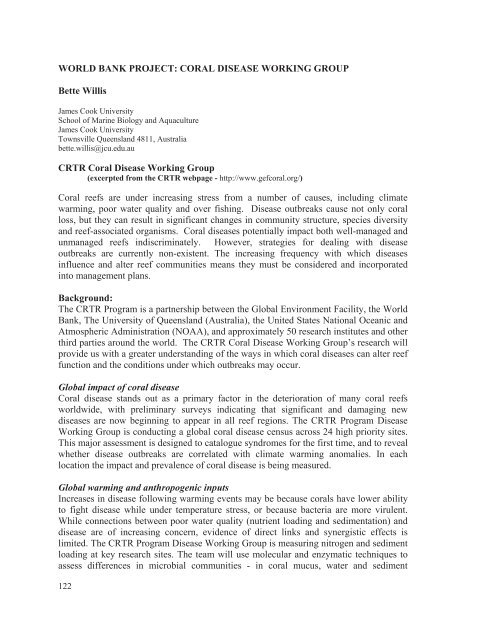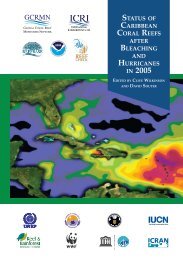Coral Health and Disease in the Pacific: Vision for Action
Coral Health and Disease in the Pacific: Vision for Action
Coral Health and Disease in the Pacific: Vision for Action
Create successful ePaper yourself
Turn your PDF publications into a flip-book with our unique Google optimized e-Paper software.
WORLD BANK PROJECT: CORAL DISEASE WORKING GROUPBette WillisJames Cook UniversitySchool of Mar<strong>in</strong>e Biology <strong>and</strong> AquacultureJames Cook UniversityTownsville Queensl<strong>and</strong> 4811, Australiabette.willis@jcu.edu.auCRTR <strong>Coral</strong> <strong>Disease</strong> Work<strong>in</strong>g Group(excerpted from <strong>the</strong> CRTR webpage - http://www.gefcoral.org/)<strong>Coral</strong> reefs are under <strong>in</strong>creas<strong>in</strong>g stress from a number of causes, <strong>in</strong>clud<strong>in</strong>g climatewarm<strong>in</strong>g, poor water quality <strong>and</strong> over fish<strong>in</strong>g. <strong>Disease</strong> outbreaks cause not only coralloss, but <strong>the</strong>y can result <strong>in</strong> significant changes <strong>in</strong> community structure, species diversity<strong>and</strong> reef-associated organisms. <strong>Coral</strong> diseases potentially impact both well-managed <strong>and</strong>unmanaged reefs <strong>in</strong>discrim<strong>in</strong>ately. However, strategies <strong>for</strong> deal<strong>in</strong>g with diseaseoutbreaks are currently non-existent. The <strong>in</strong>creas<strong>in</strong>g frequency with which diseases<strong>in</strong>fluence <strong>and</strong> alter reef communities means <strong>the</strong>y must be considered <strong>and</strong> <strong>in</strong>corporated<strong>in</strong>to management plans.Background:The CRTR Program is a partnership between <strong>the</strong> Global Environment Facility, <strong>the</strong> WorldBank, The University of Queensl<strong>and</strong> (Australia), <strong>the</strong> United States National Oceanic <strong>and</strong>Atmospheric Adm<strong>in</strong>istration (NOAA), <strong>and</strong> approximately 50 research <strong>in</strong>stitutes <strong>and</strong> o<strong>the</strong>rthird parties around <strong>the</strong> world. The CRTR <strong>Coral</strong> <strong>Disease</strong> Work<strong>in</strong>g Group’s research willprovide us with a greater underst<strong>and</strong><strong>in</strong>g of <strong>the</strong> ways <strong>in</strong> which coral diseases can alter reeffunction <strong>and</strong> <strong>the</strong> conditions under which outbreaks may occur.Global impact of coral disease<strong>Coral</strong> disease st<strong>and</strong>s out as a primary factor <strong>in</strong> <strong>the</strong> deterioration of many coral reefsworldwide, with prelim<strong>in</strong>ary surveys <strong>in</strong>dicat<strong>in</strong>g that significant <strong>and</strong> damag<strong>in</strong>g newdiseases are now beg<strong>in</strong>n<strong>in</strong>g to appear <strong>in</strong> all reef regions. The CRTR Program <strong>Disease</strong>Work<strong>in</strong>g Group is conduct<strong>in</strong>g a global coral disease census across 24 high priority sites.This major assessment is designed to catalogue syndromes <strong>for</strong> <strong>the</strong> first time, <strong>and</strong> to revealwhe<strong>the</strong>r disease outbreaks are correlated with climate warm<strong>in</strong>g anomalies. In eachlocation <strong>the</strong> impact <strong>and</strong> prevalence of coral disease is be<strong>in</strong>g measured.Global warm<strong>in</strong>g <strong>and</strong> anthropogenic <strong>in</strong>putsIncreases <strong>in</strong> disease follow<strong>in</strong>g warm<strong>in</strong>g events may be because corals have lower abilityto fight disease while under temperature stress, or because bacteria are more virulent.While connections between poor water quality (nutrient load<strong>in</strong>g <strong>and</strong> sedimentation) <strong>and</strong>disease are of <strong>in</strong>creas<strong>in</strong>g concern, evidence of direct l<strong>in</strong>ks <strong>and</strong> synergistic effects islimited. The CRTR Program <strong>Disease</strong> Work<strong>in</strong>g Group is measur<strong>in</strong>g nitrogen <strong>and</strong> sedimentload<strong>in</strong>g at key research sites. The team will use molecular <strong>and</strong> enzymatic techniques toassess differences <strong>in</strong> microbial communities - <strong>in</strong> coral mucus, water <strong>and</strong> sediment122
















